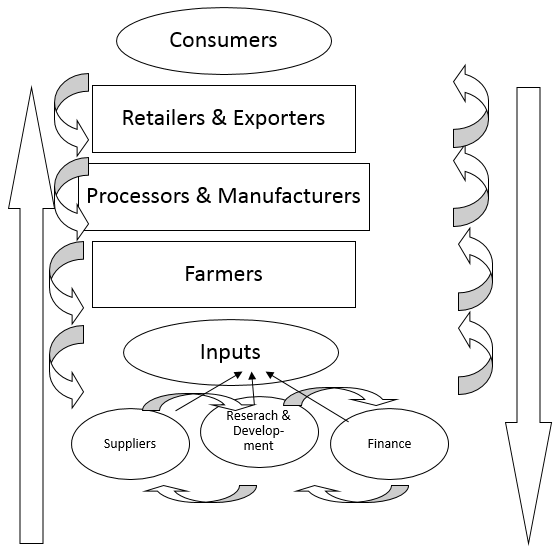
In a Value Chain marketing system, farmers are linked to the needs of consumers, working closely with suppliers and processors to produce the specific goods required by consumers. Using this approach, and through continuous innovation and feedback between different stages along the value chain, the farmer's market power and profitability can be enhanced. Rather than focusing profits on one or two links, players at all levels of the value chain can benefit. Well-functioning value chains are said to be more efficient in bringing products to consumers and therefore all actors, including small-scale producers and poor consumers, should benefit from value chain development.
The market is based on integrated transactions and information. Consumers purchase products that are produced according to their preferences. The farmer becomes the core link in producing the products that the consumers desire.
Research and development, whilst including techniques targeted at increased production, is also focused on consumer needs and attempts to take account of all of the links, and dependencies in the value chain, e.g., processing, environmental and social costs or considerations, as well factors such as health impacts, education and learning.
Communication is in both directions. It is important that both consumers and processors are made aware of factors limiting production, just as much as farmers and other producers are made aware of consumer requirements.
The value chain can help you analyse the external as well as the internal environment with regard to production and marketing.
External market analysis can include finding answers to the following questions:
- How the products you produce reach the final consumer.
- The structure (economic relationships) between players in the chain.
- How this structure is likely to change over time.
- The key threats to the entire value chain.
- The key determinants of your share of the profits created by your chain.
Internal product analysis (with the aim of marketing your product) can include finding answers to the following questions:
- How the products you produce reach the final consumer.
- The structure (economic relationships) between players in the chain.
- How this structure is likely to change over time.
- The key threats to the entire value chain.
- The key determinants of your share of the profits created by your chain.
Value chains can be used to identify sources of increased efficiency and to facilitate ‘benchmarking’ of how competitors create value and how their activities compare with yours. Value chain analysis has four underlying elements:
- Identifying the cost of each activity.
- Understanding what factors are driving the costs behind each activity.
- Monitoring the processes of competitor organisations in relation to each activity ("benchmarking").
- Understanding the linkages in the chain and horizontal strategy opportunities.
You may find that even a very simple overview of an organisation's value chain gives a great deal of insight into its relative strengths and weaknesses. It is also the case that imaginative approaches to reconstructing (‘reconfiguring’) the value chain can release new ways of clustering resources and therefore new types of capability within organisations.
Analysis of the value chain enables us to identify where an organisation's distinctive capabilities are based. They may arise from clear advantages functions (e.g., R&D, manufacture), or from the integration of individual functional capabilities. These distinctive capabilities give rise to core competencies, which are what make the organisation what it is. They are the key to the continued success of the institution, and effective strategies need to recognise and build on them.
Value chain analysis, together with an understanding of an organisation's key capabilities, can provide a basis for decisions about whether to integrate all stages of the value chain within the same organisation or to enter into partnerships with other organisations better equipped to deliver some of those stages. Equally, value chain analysis may allow an organisation to make decisions about whether to extend its activities up or down the value chain. Certain activities on any value chain might add a high proportion of financial value to the finished product or service: these are known as high value-added activities.
Know Your Markets, Protect Your Profits and Add Value to Your Products
- Diversify enterprises.
- Market outside the commodity supply chains and corporate vertical integrators.
- Emphasize direct marketing and premium speciality markets.
- Consider forming a cooperative with other farmers.
- Add value through on-farm processing.
The structure of the value chain will have a direct impact on you and your direct competitors’ profitability.
To a large extent, the amount of profit that can be obtained by you is dependent upon the final value that your entire value chain delivers to the consumer. It is also important to realise that your value chain also competes against other value chains that may be delivering products and services to the same customers that your chain delivers to. Agricultural businesses that focus only on the firms nearest to them in the value chain are not likely to anticipate major structural changes that can dramatically impact their profitability.
No matter how you end up adding value to your farm products, these principles apply:
- Start small and grow naturally.
- Make decisions based on good records.
- Create a high-quality product.
- Follow demand-driven production.
- Get everyone involved.
- Keep informed.
- Plan for the future.
- Evaluate continuously.
- Persevere.
- Capitalise adequately.
- Focus.
Click here to view a video about Porter's explanation of the value chain.